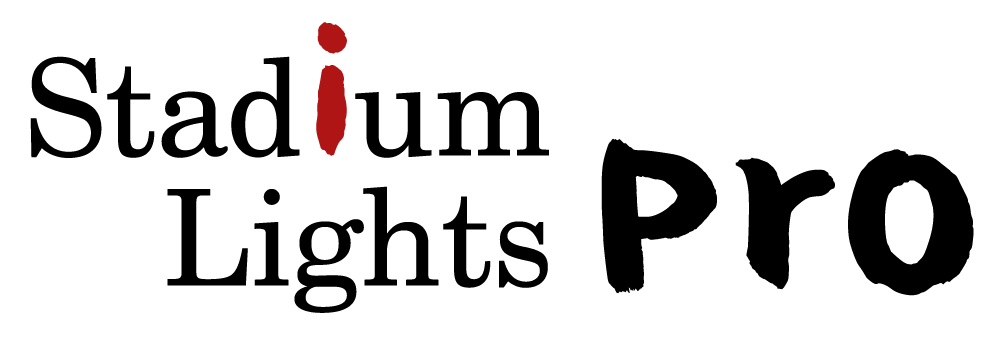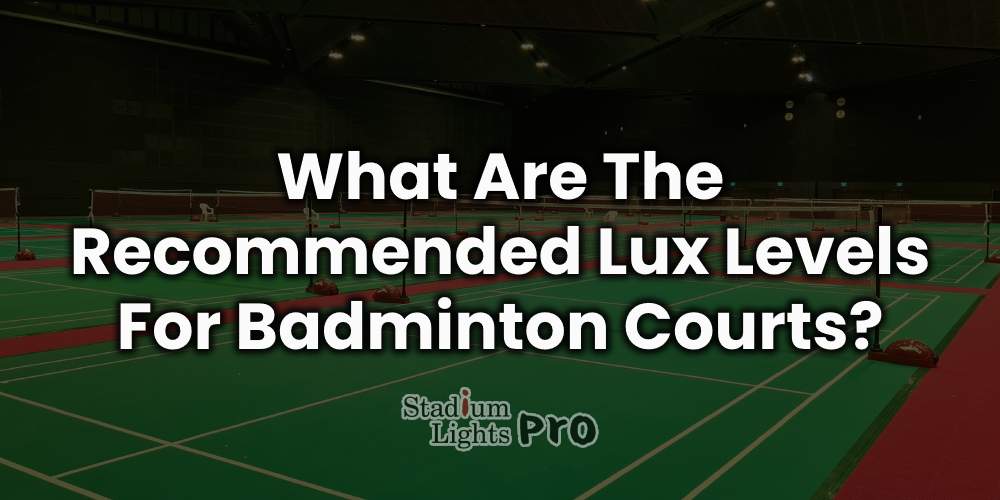Lux levels, a measurement of illuminance, directly indicate the amount of light falling on a surface area. In badminton courts, achieving optimal lux levels is critical for creating a conducive playing environment. High lux levels contribute to enhanced visibility, allowing players to track the shuttlecock accurately and anticipate their opponent’s moves effectively. On the other hand, insufficient lux levels may result in shadows, glare, or dimly lit areas, compromising player performance and increasing the risk of accidents or injuries.
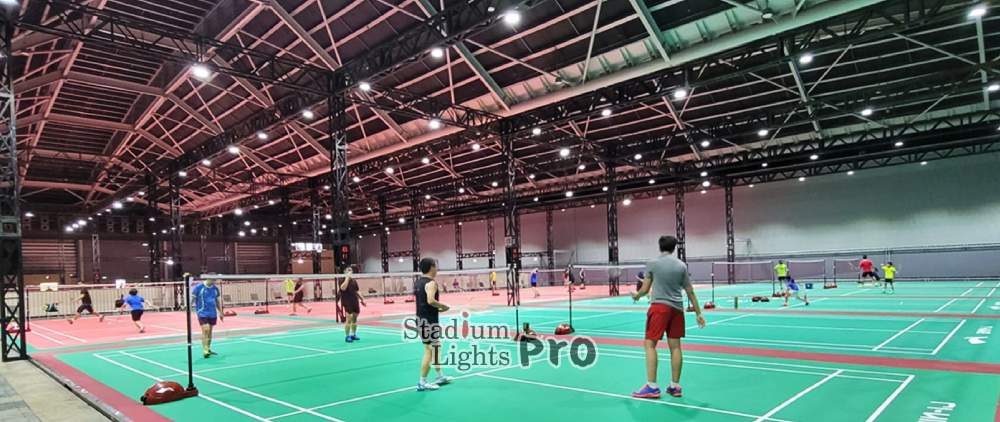
Table of Contents
ToggleUnderstanding Lux Levels
Definition of Lux and Its Relevance to Lighting
Lux is a unit of measurement that quantifies illuminance, or the amount of visible light that falls on a surface. In the context of badminton courts and sports lighting in general, lux levels indicate how well-lit an area is. This measurement is crucial because it directly affects visibility, which is paramount for players to perform at their best and for spectators to enjoy the game.
How Lux Levels Are Measured and Their Significance in Sports Lighting
Lux levels are typically measured using a device called a lux meter, which calculates the amount of light reaching a specific area per square meter. In sports lighting, including badminton courts, achieving the right lux levels is essential for several reasons:
Firstly, adequate lux levels ensure that players have optimal visibility of the court, including the lines, net, and most importantly, the shuttlecock. This visibility enables players to react quickly and accurately, contributing to the fluidity and competitiveness of the game.
Secondly, lux levels impact the overall atmosphere and experience for spectators. Properly lit courts enhance the viewing experience by allowing spectators to follow the game effortlessly and appreciate the skills of the players.
Moreover, maintaining consistent and appropriate lux levels is crucial for player safety. Insufficient lighting can create shadows or dark spots on the court, increasing the risk of collisions or injuries during fast-paced movements.
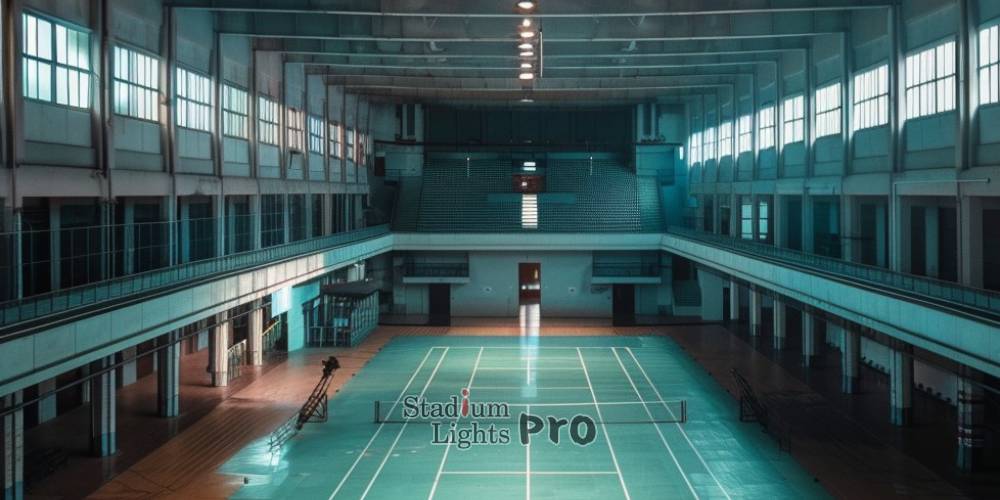
Recommended Lux Levels for Badminton Courts
Indoor Courts
Ideal Lux Levels for Professional Tournaments
For professional badminton tournaments held in indoor courts, the recommended lux levels typically range between 500 to 1000 lux. These higher lux levels ensure optimal visibility for players, allowing them to track the fast-moving shuttlecock accurately and react swiftly during intense matches. The even distribution of light across the entire court is crucial to eliminate shadows and maintain consistency in playing conditions.
Recommended Lux Levels for Recreational Play
In recreational indoor badminton courts, a slightly lower range of around 300 to 500 lux is generally sufficient. While not as demanding as professional tournaments, these lux levels still provide adequate lighting for players to enjoy the game comfortably and play with reasonable visibility. Adjustments can be made based on the specific size and layout of the court to ensure uniform illumination throughout.
Outdoor Courts
Lux Level Considerations for Outdoor Environments
Outdoor badminton courts require careful consideration of lux levels due to natural lighting variations and environmental factors such as weather conditions. Generally, lux levels for outdoor courts range from 200 to 500 lux. This range takes into account factors such as the presence of natural light during daylight hours and the need for supplementary lighting during evening play.
Factors Affecting Outdoor Lighting Requirements
Several factors influence the lighting requirements for outdoor badminton courts
Location and Orientation
Courts located in areas with varying natural light conditions may require adjustable lighting systems to compensate for changes in sunlight throughout the day.
Weather Conditions
Outdoor lighting systems should be weather-resistant and capable of maintaining consistent performance in rain or humidity.
Energy Efficiency
Given the extended operational hours of outdoor courts, energy-efficient lighting solutions such as LED technology are preferred to minimize electricity consumption and operational costs.
Ensuring appropriate lux levels in both indoor and outdoor badminton courts is essential for optimizing playing conditions, promoting player safety, and enhancing the overall experience for participants and spectators alike. Balancing these considerations helps create an environment conducive to enjoyable and competitive play across different levels of the sport.
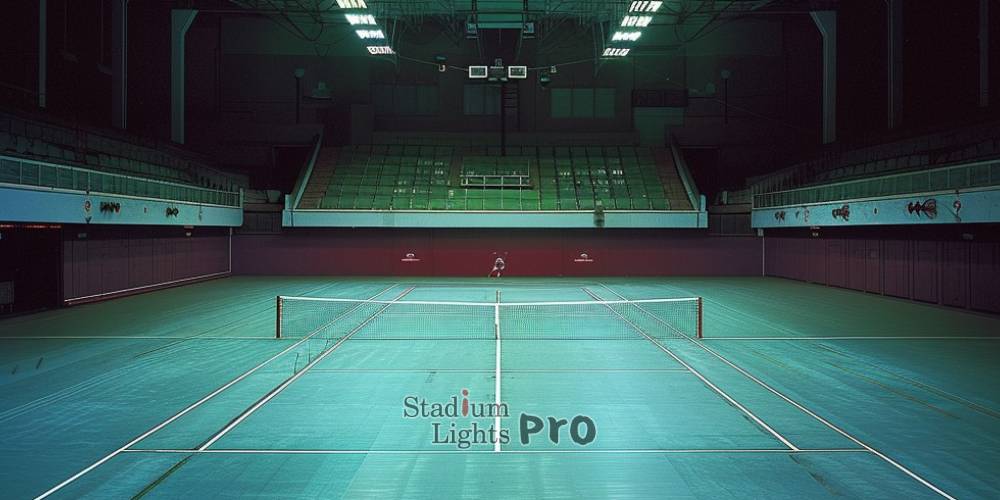
Factors Influencing Lux Requirements
Lux requirements for badminton courts are influenced by several key factors that affect the distribution and intensity of lighting across the playing area:
Court Size and Dimensions
The size and dimensions of the badminton court directly impact the lux requirements. Standard badminton courts have specific dimensions (13.4 meters in length for singles, 6.1 meters for doubles) that dictate the spread and intensity of lighting needed to ensure uniform illumination. Larger courts may require higher lux levels to maintain consistent brightness across the entire playing surface, whereas smaller courts may suffice with lower lux levels.
Ceiling Height and Reflective Surfaces
The height of the ceiling above the court and the presence of reflective surfaces play a crucial role in determining lux requirements. Higher ceilings allow for better distribution of light and reduce the risk of glare or shadows on the court. Reflective surfaces, such as glossy flooring or walls, can enhance the overall lighting by bouncing light back onto the playing surface, thereby reducing the need for excessively high lux levels.
Spectator Areas and Peripheral Lighting Needs
Lux requirements extend beyond the playing surface to include spectator areas and peripheral zones around the court. Adequate lighting in spectator areas ensures optimal viewing conditions for audiences, enhancing their overall experience during matches. Peripheral lighting, such as along walkways or near seating areas, contributes to the safety and comfort of spectators navigating around the facility.
Considering these factors ensures that lux levels are tailored to meet the specific needs of the badminton court environment. By addressing court size, ceiling height, reflective surfaces, and peripheral areas, facility managers can optimize lighting conditions to enhance gameplay, ensure player safety, and provide an enjoyable experience for spectators.
Lighting Technologies for Badminton Courts
When selecting lighting for badminton courts, understanding the advantages and considerations of different technologies is crucial:
LED Lighting
Benefits and Suitability for Different Court Types
LED (Light Emitting Diode) lighting has gained popularity in badminton courts for several reasons:
LEDs are highly energy-efficient, consuming less electricity than traditional lighting systems. This efficiency translates to cost savings and reduced environmental impact. LEDs also have a longer lifespan, requiring less frequent replacement and maintenance compared to traditional bulbs. They provide instant illumination without warm-up time, offering flexibility in lighting control and scheduling. Additionally, LEDs can be designed for directional lighting, minimizing light spillage and ensuring uniform illumination across the court.
Traditional Lighting Systems: Pros and Cons
Traditional lighting, such as metal halide or fluorescent lamps, remains in use for some badminton courts:
These systems generally have lower initial costs compared to LEDs, making them a more economical choice upfront. Some traditional lighting options provide good color rendering, crucial for accurate visibility of the shuttlecock and court markings. However, traditional systems often consume more energy and have shorter lifespans, leading to higher operational costs over time due to increased electricity usage and frequent bulb replacements.
Impact of Lighting on Energy Efficiency and Maintenance Costs
The choice of lighting technology significantly impacts both energy efficiency and maintenance costs:
Switching to LED lighting can result in substantial energy savings, often up to 50% or more compared to traditional systems. This reduction in energy consumption not only lowers utility bills but also contributes to sustainability goals. LEDs require minimal maintenance due to their longer lifespan and durability, reducing the need for frequent bulb replacements and maintenance labor. This results in fewer disruptions to court availability and lower overall maintenance costs over the long term.
Case Studies and Examples
Examples of Well-Lit Badminton Facilities
Several badminton facilities around the world have implemented effective lighting solutions to enhance player performance and spectator experience:
Singapore Badminton Hall (Singapore)
Renovated with state-of-the-art LED lighting, providing uniform illumination across multiple courts. The LED fixtures offer high color rendering index (CRI) for excellent visibility of shuttlecocks and player movements.
National Badminton Centre (England)
Utilizes a hybrid lighting system combining LED and traditional metal halide lamps. This setup balances energy efficiency with sufficient light intensity, catering to both training sessions and professional tournaments.
Tokyo Metropolitan Gymnasium (Japan): Upgraded to LED lighting to reduce energy consumption and improve lighting quality. The new fixtures ensure consistent brightness throughout the facility, meeting international standards for tournament play.
Comparison of Different Lighting Solutions in Practice
When comparing lighting solutions for badminton courts, factors such as energy efficiency, maintenance requirements, and lighting quality play significant roles:
LED vs. Traditional Systems
LED lighting generally offers superior energy efficiency and longer lifespan compared to traditional metal halide or fluorescent systems. LED fixtures consume less energy, resulting in lower operational costs over time. They also require less frequent maintenance due to their extended lifespan, reducing downtime and maintenance expenses.
Color Rendering and Visibility
LED lighting often provides better color rendering and uniform illumination compared to traditional lighting, enhancing visibility of fast-moving shuttlecocks and player actions. This improves gameplay and spectator experience by reducing glare and shadows on the court.
Flexibility and Control
LED technology allows for precise control over lighting levels and distribution. Some systems offer dimming capabilities and programmable settings, adapting to different playing conditions and maximizing energy savings during non-peak hours.
Environmental Impact
LED lighting contributes to sustainability goals with lower energy consumption and reduced carbon footprint. By choosing energy-efficient lighting solutions, badminton facilities can minimize environmental impact while optimizing operational efficiency.
Practical Considerations for Installation
Installing lighting for badminton courts involves several practical considerations to ensure optimal performance, flexibility, and compliance with regulations.
Designing a Lighting Layout for Optimal Coverage
Creating a lighting layout that provides uniform illumination across an entire badminton court is crucial for enhancing player visibility and safety. Achieving consistent light levels is key to minimizing shadows and glare, ensuring players can see the shuttlecock and other court features clearly. This uniform lighting not only improves gameplay but also contributes to overall player safety by reducing the risk of accidents caused by poor visibility.
One effective strategy is to divide the court into zones and adjust the lighting levels according to specific needs. For instance, the center of the court may require more intense lighting compared to the peripheral areas. This zoning allows for tailored illumination that can better accommodate the different activities and movements that occur in various parts of the court.
The placement of light fixtures also plays a vital role in achieving optimal lighting. Positioning fixtures at appropriate heights and angles ensures maximum light distribution across the court and helps minimize light spillage beyond its boundaries. This careful positioning is essential to maintain the integrity of the court’s lighting without causing distractions or disturbances to adjacent areas.
Reflective surfaces such as walls and flooring must be considered when planning the lighting layout. Reflective surfaces can impact brightness and glare, so adjusting fixture placement to account for these reflections can further optimize the lighting. By carefully considering these factors, it’s possible to create a lighting layout that enhances both the functionality and safety of the badminton court.
Adjustability and Control Systems for Flexibility in Lighting Levels
Incorporating adjustability and control systems into the lighting design provides valuable flexibility in managing illumination levels on a badminton court. This flexibility can be achieved through the installation of dimmable LED fixtures or lighting systems that allow adjustments in lighting intensity. Such systems enable the lighting to be adapted to different activities or changes in natural light throughout the day, ensuring optimal visibility under varying conditions.
Implementing programmable lighting controls further enhances this flexibility by automating lighting schedules and adapting to different usage patterns of the court. For example, the lighting can be programmed to increase intensity during peak usage times or special events and dim during off-peak hours. This automation not only improves the user experience but also contributes to energy efficiency by reducing unnecessary lighting.
Moreover, utilizing systems with remote access capabilities offers convenient monitoring and adjustment of lighting settings from a centralized location. This feature allows for real-time control and responsiveness to immediate needs or changes, such as quickly adjusting the lighting for a special event or maintenance activities. Overall, these adjustable and controllable systems ensure that the lighting on the badminton court can be precisely managed to meet various requirements, enhancing both functionality and energy efficiency.
Compliance with Regulations and Standards
Ensuring compliance with local and international regulations and standards governing sports facility lighting is essential for the effective and safe illumination of badminton courts. Adhering to recommended lux levels specific to badminton is crucial, as these guidelines take into account factors such as court size, intended usage, and competition requirements. Proper adherence ensures that the lighting provides sufficient visibility for players while minimizing shadows and glare, which is critical for both recreational and competitive play.
Selecting lighting solutions that meet energy efficiency standards is also important. These standards help minimize environmental impact and reduce operational costs by ensuring that lighting systems use energy effectively. By choosing energy-efficient fixtures and systems, facilities can lower their carbon footprint and achieve cost savings through reduced energy consumption.
By carefully considering these practical aspects during the installation of lighting systems for badminton courts, facilities can optimize lighting performance and create a safe, enjoyable environment for everyone involved. Such attention to detail enhances the user experience, provides a suitable environment for players and spectators, and supports the overall functionality and sustainability of the facility.
Conclusion
Achieving the recommended lux levels is crucial for visibility, performance, and safety, whether in indoor or outdoor settings. The selection of appropriate lighting technologies, such as energy-efficient LED systems, further contributes to long-term cost savings and sustainability. By carefully considering court dimensions, reflective surfaces, and regulatory standards, facility managers can create a well-lit environment that promotes competitive play and enjoyable experiences for all.
